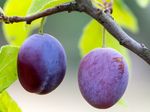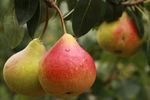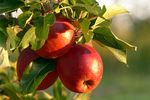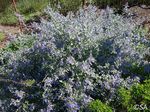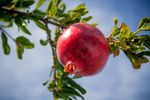Horticulture Update Concho Valley - Texas A&M AgriLife Extension County ...
←
→
Page content transcription
If your browser does not render page correctly, please read the page content below
Concho Valley January 2022
Horticulture Update
January Landscaping
January To-Do's
It’s tough to figure out what to do in the winter landscape when it’s
been so consistently warm all through December. The nights are
chilly and days are shorter, so some plants are going into winter Plant bare root fruit
dormancy but others are hanging on through the spring-like trees
weather. Irises have been blooming and bermudagrass lawns are
still fairly green.
Prune shade trees if
Leaves have just about finished dropping and should not be
bagged up to take up space in the landfill, but used as valuable needed
organic matter in the landscape. Most leaves can just be mowed
over on the lawn to shred and break down into the soil, or they can
be gathered up for a compost bin or used as mulch in the garden. Need to move a plant in
Water needs are greatly reduced and irrigation should be reduced the yard? Now is the
to match. Water lawns, shrubs etc thoroughly once every three to
four weeks when there’s no rain. Water winter vegetables and time - while dormant.
annual color in beds and containers as needed, up to a couple Works best if the plant
times per week depending on weather.
is young and small
Clean up frost-damaged perennial tops, and even those that have
not been killed by frost can be cut back so mulch can be
replenished to protect roots when it gets colder. Ornamental Order seeds from
grasses can still provide aesthetic value after they turn brown, so catalogs and online for
they can be left for the structure and interest they provide but be
sure to cut down to the ground in late winter before new green spring
growth appears.
Winter is a great time of year to work on soil improvement. It can
be physically demanding but very simple. Just remember the Pecan Update
phrase ‘compost once, mulch forever.’ Any spots in the yard that
need rejuvenation, or any new beds or gardens that will be added
in the spring, should be tilled up to loosen and aerate the heavy Thank you to everyone who
soil. Incorporate organic matter (well-finished compost) to
maximize the tilling step and allow the soil to stay loosened and entered the Concho Valley
porous instead of settling back into compaction. Roots need to
‘breathe’ and allowing oxygen to penetrate into the soil more Pecan Show!
readily can make a huge difference in plant health and growth. And
organic matter provides important nutrients and provides many
crucial functions for healthy plant growth.
December through January is also a good opportunity to prune A full report of the results
shade trees. Wait until it cools down more to prune oaks, to ensure
that the nitidulid beetle that can spread oak wilt disease is dormant. and awards are available at
Don’t remove more than a third of the canopy in one year, unless
it’s dead wood – like ash trees heavily damaged in the February https://tomgreen.agrilife.org/
winter storm.Hobby Greenhouses Winter is taking it’s time coming around, but every year during this season there are questions about hobby greenhouses as it gets colder. Many homeowners would like to have a place to overwinter valuable tropical plants and be able to extend the growing season. A small hobby greenhouse can be very useful and helpful but does require a lot of effort and time to keep it functional. And small greenhouses are more difficult to maintain a constant temperature and steady environment inside, so the largest that is feasible and would fit in the home landscape the better. The main factors to consider with creating a hobby greenhouse are winter heating, summer cooling and a watering system. As hot as it gets in the south, greenhouses can lose their usefulness in the summer unless a good ventilation and cooling system is incorporated. But for many homeowners, winter is the only time they need one. A well designed and properly placed greenhouse can take advantage of sunlight to stay warmer inside. Use the clearest possible material to cover the greenhouse to allow as much light through as possible. A lean-to greenhouse placed on the south or west side of a building can take advantage of both sunlight and radiant warmth from the building to help keep plants from freezing. A heater will be required for cold nights and to get through any particularly chilly winter spells. Only use heaters that are designed and labeled for greenhouses and that can be used around water. Be careful to not let the greenhouse get too hot during warm, sunny days that frequently come during winter because of our very changeable, erratic weather. Install vents that can be opened when it’s hot and open up doors to allow air circulation. In the summer, utilize greenhouse shade cloth, vents, fans and evaporative cooling to limit the amount of light coming in and help keep plants cool if the greenhouse is to be used year-round. Water should be easily accessible in the greenhouse; depending on the types of plants and the season, daily watering may be required. Even though the plants are inside a structure, the weather outside will impact how quickly they dry out. Water more frequently during sunny, windy, dry weather. Be careful not to overwater when it’s cooler, humid and cloudy. Plant Spotlight Bush Germander Teucrium fruticans This small shrub grows about four feet tall and wide, does best in full sun but can take part shade. Drought tolerant, don't overwater. Great for bees and butterflies and makes a beautiful fragrant addition for the landscape.
Vegetables to Plant Now Plant Trees and Shrubs
We never know what kind of weather we will have Fall through early winter is the ideal time to plant
from one week to the next during west Texas winter
– it may be warm and sunny, or a cold front may trees and shrubs. Summer is tough on plants,
come through with frigid temperatures. But it’s a especially newly planted ones, so giving them as
pretty safe assumption that we will have plenty of much time as possible to establish roots before it
pleasant weather. Though the extreme and gets hot increases chances of success.
changeable weather can make gardening difficult,
we are fortunate that the ground doesn’t freeze and Trees are the most valuable part of the
we can keep gardening all year long. So take landscape, and shrubs are important permanent
advantage of a pleasant day and grow some food in elements as well, so plan carefully, use good
the landscape! design and proper planting technique. Taller
shrubs look best when placed at the corners of
January-February is a great time of year to plant the home – they can help it look wider and more
many vegetables. Start out in January with open. Don’t cover windows with tall shrubs, or
establishing some asparagus and planting onion stagger them between the windows, as that can
sets. Asparagus is a great vegetable to grow for break up the visual flow across the front of the
many reasons – it can tolerate our salty, alkaline home and make it look smaller. Use dwarf shrubs
soil and water, it is one of the few perennial for the front of the home so they don’t get too tall
vegetables that we can grow, and it’s healthy and and require frequent pruning.
delicious! The only drawback to planting asparagus
is that it does take time to get a well-established
stand going before ever harvesting. Asparagus Depending on the specific landscape, a good
should be allowed to grow for two years from general rule of thumb is to place trees at 45-
planting crowns without harvesting, or three years degree angles off the front corners of the home –
from seed. It seems like a long time but it’s worth not in front, visually ‘dividing’ the home into
getting started! sections, but framing it to highlight the home. The
right planting depth is very important – only plant
Purchase asparagus crowns from a local nursery or trees as deep as the rootball; don’t place in a
garden center, or order from a seed catalog.Dig deeper hole that requires soil to be filled in over
furrows about six to twelve inches deep, and space the roots. Sometimes nursery trees even have
the crowns at least twelve inches apart. Cover too much soil over the rootball in the container, so
firmly with an inch of compost and two or three check to see if there is loose soil that can be
inches of soil. Over the coming season, finish filling scraped off the top. Remove excess soil until you
the trenches as the shoots grow. Water thoroughly see roots matted into soil, and dig the hole to
after planting, and water every week or so after match the depth of the rootball. Very large, heavy
emerging (depending on rainfall and temperature). trees can even be planted slightly above grade
because their weight will cause them to settle in a
Onions are biennial, so if started by seed they take little deeper over time. Trees planted too deep will
two years to produce a good-sized have issues later on – the canopies will not be as
bulb.Transplants, also called onion sets, are a good
way to grow full sized onions in one season instead attractive and they will not grow as vigorously.
of two years. Onion sets can be found in local
nurseries, through mail order catalogs and online. Improve soil with compost before planting shrubs,
Choose short day varieties for planting in the south but not trees. Only the native soil dug from the
– some examples include Granex, Crystal White, hole should be used to fill after planting; trees are
and Red Burgandy. too large to amend all the soil their roots will
occupy, so choose well-adapted species that do
Then in February it’s time to plant potatoes. well in the local soil and climate. Apply a three to
Potatoes are a cool weather crop, but not a winter four-inch-deep layer of mulch after planting trees
crop. They grow best when the days are warm and and shrubs, but don’t pile it around the trunk like
nights are cool, and don’t like the heat of summer. a volcano – that can be stressful to the plants.
But the top of the plant can’t handle freezing Mulch helps trees and shrubs get established
temperatures. February is a good time to plant, as faster because it helps keep weed competition
the seed piece starts out protected from cold under control, moderates soil temperature, and
temperatures in the soil and the plant top emerges conserves water.
after danger of frost has passed.
Also consider adding some of these cool-season
vegetables, there are lots of options that do well
when planted from late January through February:
beets, broccoli, brussels sprouts, cabbage, carrots,
cauliflower, collards, kale, kohlrabi, lettuce, radish,
spinach.Fruit Trees in the Landscape A home landcsape can be productive as well as beautiful, filled with plants that provide delicious home-grown fruit, vegetables and herbs. January is a great time of year to plant fruit trees, so here are some tips to get started. Container grown trees can be planted year-round, though summer is the most difficult time of year to establish them. Bare-root fruit trees should only be purchased and planted in the dormant winter season, so don’t wait too long – when it warms up in late winter and early spring it’s too late to have good success planting bare-root. Some of the recommended fruit tree options for the Concho Valley include peaches (varieties such as Ranger, Redglobe, Loring, Harvester); plums (Morris, Methley, Santa Rosa); pears (Orient, Moonglow, Le Conte); apples (Fuji, Holland, Gala); and pomegranates (Salavatski, Sumbar, Al-Sirin-Nar, Surh Anor). The options don’t end there, also consider figs, persimmons, apricots, and jujubes. Winter is also a great time of year to plant pecan trees, and some of the improved varieties that are recommended for the area include Pawnee, Nacono, Hopi, Western, Waco and Sioux. Blackberries will do well in the local soil and climate – though they are large sprawling plants and many varieties are very thorny. So keep that in mind when choosing a spot to plant. Some thornless varieties to choose from include Ouachita and Natchez, while thorny varieties that would be good include Kiowa, Womack, and Rosborough. Blackberries are biennial plants and make fruit on two- year old stems (called canes). At the end of the growing season, prune off canes that made fruit but leaves the rest of the canes to make fruit the following year (don’t just cut the whole plant to the ground). Grapes are a nice addition to a landscape with a large fence, arbor, pergola or other structure that could support a large heavy vine. Champanel is a wonderful variety for landscape arbors. Other grapes that would work include table grapes like Mars, Reliance, and Flame Seedless; wine grapes can also do well, such as Cabernet Sauvignon, Merlot, and Tempranillo. For more detailed info on growing any of these fruit crops, visit https://aggie-horticulture.tamu.edu/. Pruning Trees Though pruning can technically be done any season, the dormant winter is most appropriate for pruning shade trees - before they use up stored food to develop new growth in the spring. But exceptions to this guideline would be trees that flower in the early spring, like redbuds; wait until after they finish flowering to prune. And evergreens like pines and junipers should be pruned in spring – before candles form on pines, and around early May for junipers (though evergreens generally need little to no pruning). Winter is also a good time of year specifically for oaks because of the potential spread of oak wilt disease. Oak wilt can be spread several ways – root grafts, contaminated tools, and a tiny insect called the nitidulid beetle. The beetle can potentially spread the disease through wounds like pruning cuts, but the insect is dormant in the winter making it less likely. A backup plan is to paint the pruning cuts with spray paint, which is recommended any time pruning is done when the beetle is active but is also a good move during the winter as a double measure of protection. With the warm, mild winter we have had spraying pruning cuts of oaks trees is definitely recommended. Tools should be sterilized with rubbing alcohol or 10% bleach solution between trees. The first goal of pruning should be to remove dead, damaged or broken limbs. After that, consider the form of the tree and check branch angles- wide angles are stronger, while narrow angles and branches growing close together are weak and have greater chances of failure. Make carefully planned removal or reduction cuts to promote good tree structure and strength. Branch attachments should have a 2:1 ratio, meaning the smaller branch diameter should be half as wide as the larger branch it’s attached to. This kind of training for good branch angles and ratios is much more effective when started on young trees, rather than trying to correct large mature trees. Try to not to cut branches with diameter greater than six inches. Pruning should not be thought of as a ‘one-time-fix’ job that can immediately transform a tree into the right shape, but as a gradual process of maintaining tree health and structure. Avoid ‘lion tailing’ trees, which is easy to do to large tall shade trees. Thinning out the interior of the canopy, the branches that are easier to reach, and leaving tufts of leaves and small branches at the end will damage the health and structure of the tree.
Upcoming Events
January 2021
Tuesdays February through May, 5:30pm
Master Gardener Training Class
Location: Tom Green 4H Center, 3168 N US Highway 67
Cost: $225
Details to be announced soon - visit txmg.org/conchovalley or contact the Extension Office at
325-659-6528 to sign up.
Thursday, January 6, 2pm-4pm
West Texas Gardening 101 - Aging With Your Landscape
Location: People/Plant Connection Headquarters, 416 South Oaks St, San Angelo
Cost: $20
Speaker: Ron Knight
Hosted by the PPC; Whether you are a caregiver or simply can't do the gardening you used to,
this seminar will give you good information to make your landscape safe and enjoyable as you
age.. To reserve a spot Click Here or call Susan Stanfield at 325-656-3104.
Friday, January 14, 12:00pm
Lunch N Learn Class - Roses 101 - Selection, Planting and Care
Location: People/Plant Connection Headquarters, 416 South Oaks St, San Angelo
Cost: $5
Speaker: Allison Watkins
Hosted by the PPC; Join us for a discussion on what roses do well in the landscape with little
care, along with planting, pruning and other tips. To reserve a spot Click Here or call Susan
Stanfield at 325-656-3104
For more information on any of the topics, or to ask questions please contact:
Allison Watkins
Texas A&M AgriLife Extension
Tom Green County
113 W Beauregard
San Angelo, TX 76903
325-659-6528
The members of Texas A&M AgriLife will provide equal opportunities in programs and activities, education,
and employment to all persons regardless of race, color, sex, religion, national origin, age, disability, genetic
information, veteran status, sexual orientation or gender identity and will strive to achieve full and equal
employment opportunity throughout Texas A&M AgriLife.You can also read





